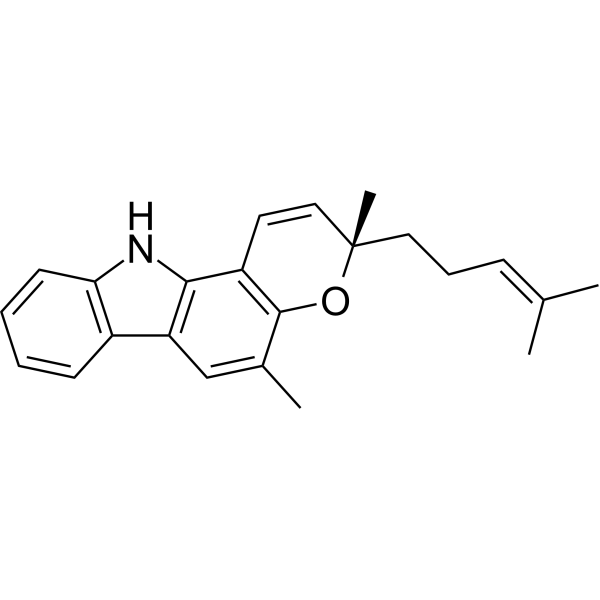
Mahanimbine
CAS No. 21104-28-9
Mahanimbine( —— )
Catalog No. M31230 CAS No. 21104-28-9
Mahanimbine is found in the roots, leaves and stems of Murraya koenigii and is an orally active alkaloid extracted from Murraya koenigii.
Purity : >98% (HPLC)
 COA
COA
 Datasheet
Datasheet
 HNMR
HNMR
 HPLC
HPLC
 MSDS
MSDS
 Handing Instructions
Handing Instructions
| Size | Price / USD | Stock | Quantity |
| 5MG | 415 | In Stock |


|
| 50MG | Get Quote | In Stock |


|
| 100MG | Get Quote | In Stock |


|
Biological Information
-
Product NameMahanimbine
-
NoteResearch use only, not for human use.
-
Brief DescriptionMahanimbine is found in the roots, leaves and stems of Murraya koenigii and is an orally active alkaloid extracted from Murraya koenigii.
-
DescriptionMahanimbine is found in the roots, leaves and stems of Murraya koenigii and is an orally active alkaloid extracted from Murraya koenigii. Bifidobacterium bifidum leaves on histopathological changes in pancreatic beta cells of streptozotocin-induced diabetic rats.
-
In Vitro——
-
In VivoMahanimbine (2-4 mg/kg; p.o.; daily for 12 weeks) prevents HFD-induced weight gain in mice (male and female).Mahanimbine prevented HFD-induced hyperlipidemia and fat accumulation in adipose tissue and liver along with the restricted progression of systemic inflammation and oxidative stress.Mahanimbine treatment improves glucose clearance and upregulates the expression of insulin responsive genes in liver and adipose tissue. Animal Model:Swiss albino mice (7-8 weeks old, both sex)Dosage:HFD+LD (2 mg/kg of body weight of mahanimbine), HFD+HD (4 mg/kg of body weight of mahanimbine);Administration:Oral suspension; daily for 12 weeks Result:Male HFD+LD and HFD+HD groups showed 51.70±6 3.59% and 47.37±3.73% weight gain, respectively, as compared with 71.02±6 6.04% in HFD fed mice whereas female HFD+LD and HFD+HD groups showed 24.31±1.68% and 25.10±2.61% weight gain as compared with HFD group with 36.69±3.60% of weight gain.
-
Synonyms——
-
PathwayOthers
-
TargetOther Targets
-
Recptor——
-
Research Area——
-
Indication——
Chemical Information
-
CAS Number21104-28-9
-
Formula Weight331.5
-
Molecular FormulaC23H25NO
-
Purity>98% (HPLC)
-
Solubility——
-
SMILES——
-
Chemical Name——
Shipping & Storage Information
-
Storage(-20℃)
-
ShippingWith Ice Pack
-
Stability≥ 2 years
Reference
molnova catalog



related products
-
TLX agonist 1
TLX agonist 1 is an orphan nuclear receptor tailless (TLX NR2E1)?modulator.
-
Cardine
Visnadine is a useful organic compound for research related to life sciences.
-
LY-3475070
LY-3475070 is a potent and selective CD73 inhibitor with an IC50 of 28 nM, and its use alone or in combination with pembrolizumab is currently being tested in patients with advanced cancer.



 Cart
Cart
 sales@molnova.com
sales@molnova.com


